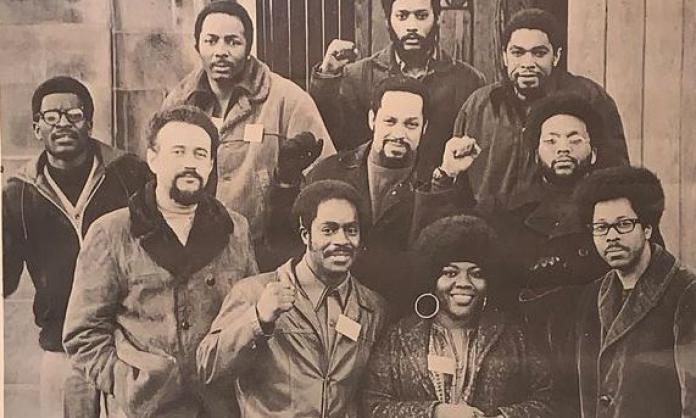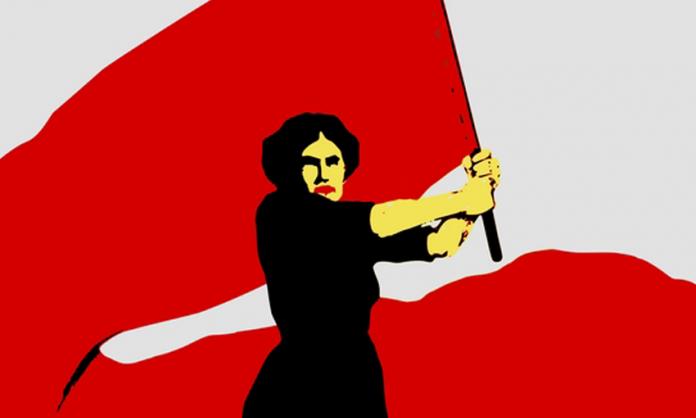Maurice Mitchell didn’t take shit from anyone. He was a semi-professional boxer and had fought in the Korean War. His son Darryl, who’s talking over the phone from San Jose, California, got his early political education at union meetings across the road from Ford’s River Rouge complex in the Detroit suburb of Dearborn, where Maurice worked as a welder.
“Each factory had their own union hall, known as a local, and the local was one of the places where workers such as my father gained a sense of power”, Darryl says. “Another place was in the boxing ring, where my father had a reputation of whooping anyone’s ass – especially off-duty police officers.” In September 1968, Maurice insisted that Darryl, who was 14 years old at the time, hand out union election material for a group calling itself the Dodge Revolutionary Union Movement (DRUM) at Chrysler’s Hamtramck Assembly Plant, or Dodge Main as it was known to locals.
DRUM’s platform attacked the United Auto Workers (UAW) for failing its members, in particular Blacks, by refusing to fight against the conditions at Dodge Main: racist hiring practices that excluded Blacks from the skilled trades and relegated them to the most dangerous positions; unsafe machinery that often resulted in injuries and deaths; speed-ups of production; increasing regimentation of tasks; and harassment from management over sick leave. But DRUM was more than just a union reform ticket. The group argued that winning union elections would not in itself improve conditions at the plant. What was needed was strike action. And their goal was the destruction of the capitalist system to achieve Black liberation.
DRUM didn’t just talk the talk. In May 1968, 4,000 workers walked off the assembly lines in response to production speed-ups. In retaliation, management fired several Black workers who they assumed were responsible for the strike, even though the majority of those who staffed the picket lines were white. In July, 4,000 workers struck again. Over three days, DRUM led hundreds of Black workers in clashes with the company, UAW officials and police – all of whom had joined forces to crush the strike. They failed: the strike cost Chrysler more than 3,000 vehicles, most workers who had been disciplined in May had their jobs reinstated, and no one was fired in retaliation.
“Black workers comprise 60 percent and upwards of the entire Hamtramck Assembly Plant, and therefore hold exclusive power”, read their election material. DRUM’s candidate for head of the local, Ron March, won the first round of elections by a narrow margin. Yet the UAW declared the results too close to call, requiring a run-off. Unable to secure victory through democratic means, the UAW officials instead turned to the police: DRUM activists were intimidated by armed gangs; their supporters were evicted from voting stations in the union hall; and ballot boxes were seized. In the run-off, March came third, and of 35 candidates, only two DRUM members were elected. “I was too young to fully appreciate the significance of everything that was unfolding”, Darryl says. “But I knew there was a serious fight going on – and we were on the right side of it.”
--------------------
While Detroit had long been a hub of US manufacturing, the economic boom after the Second World War put the city’s auto industry in the driver’s seat of industrial development. “You needed a whole set of interlocking industries to produce an automobile: steel for the chassis and frames, rubber for the tyres, glass windows, machines needed to be built for the assembly lines, roads needed to be built for the automobiles, which in turn expanded the gas and oil corporations, and the increased mobility made possible by automobiles and roads leads to the creation of the first suburbs and the growth of the construction industry”, Darryl says. Underpinning the process was a reserve army of labour that brought Blacks into the lower sections of the industrial workforce. “This meant a highly volatile situation where you had Black soldiers coming home [after the war] who would not accept the laws of segregation and second-class citizenship. You had a population that was willing to fight and kill over the question of segregation. My father was one of those men – what they called a ‘race man’.”
Black workers had long been organised in the labour movement: the American Negro Labor Congress in the 1920s, the Congress of Industrial Organisations’ left-led unions in the 1930s and 1940s, the National Labor Congress and the Trade Union Leadership conference in the 1950s. The UAW, born of this industrial militancy, had once led a series of heroic strikes, such as the 1936-37 sit-down at General Motors in Flint, Michigan, and the 1941 strikes at Ford’s River Rouge complex. Both had challenged institutional racism at these plants and allowed Black workers such as Darryl’s father to find positions in the skilled trades. But the post-war UAW sought industrial peace with the auto executives, banning strikes and accepting discriminatory job placements that ratcheted up the rate of exploitation and put the lives of Black workers at risk. Yet the legacy of radicalism lived on through the left, which welded itself onto the political architecture of the city:
“You had the old CPUSA [Communist Party] bookstore not far from Wayne State University. The SWP [Socialist Workers Party] had their bookstore upstairs on Woodward Street. Everyone would go to their meetings. There was Vaughn’s Bookstore, one of the only Black bookstores in the US and a regular meeting place for Black radicals and groups such as the Republic of New Africa. You could run into C.L.R. James, the Boggs, Raya Dunayevskaya any day of the week on the streets of Detroit. At Wayne State University there were groups like UHURU [Swahili for ‘freedom’] that had a collection of young people who would go on to form the political and intellectual basis of what would become the DRUM movement.”
The Mitchell family were members of the Freedom Now Party – a radical organisation that fought segregation – and their household a community meeting place, frequented regularly by people such as the young General Baker, who would go on to play a central role in founding DRUM, as well as Maurice’s brother Leroy, who played a key role in Baker’s early political development.
Darryl says that a key attraction of their home was the record player – “the best on the block” – since Maurice, who had studied to be an electrician, built it “before any of them hit the market”. Through it they heard the Motown sound, which expressed the confidence and energy of a new Black generation and was immortalised through hits such as Martha and the Vandellas’ “Dancing in the Street”, which became the anthem of the wave of Black-led uprisings that swept US cities in 1964-68. Taking inspiration from the legal victories against Jim Crow in the south, the uprisings aimed their fire against the forms of racial segregation that also characterised life for Blacks in the north. The largest of them would take place in Detroit in July 1967, after a police raid on an after-hours bar, known to locals as a “blind pig”.
“The people who would frequent after-hours joints were better paid workers who could afford to go there”, Darryl explains. “The club had been set up by veterans, and the door the police kicked in was a party for two veterans who had just returned from Vietnam. They were tired and fed up with the police arbitrarily arresting, jailing and killing Black people – and they weren’t going to take no shit from them any more.”
For five days and nights, up to 100,000 people participated in protests and pitched street battles with police and federal troops. More than 2,000 businesses were looted or damaged, whole city blocks paralysed by gun fights and more than 4,000 buildings razed. By the time the unrest had been subdued, 43 people had been killed, almost 2,000 injured and several thousand arrested. “It was the greatest uprising against the state since the American civil war”, Darryl says.
The uprising didn’t stop at the streets, either. Soon after, General Baker and others established a newspaper, Inner City Voice, and began agitating at Dodge Main, where Baker worked as an assembler. Darryl says that their decision to “take the uprising into the factories” was based on a simple observation: if Black workers were ready to fight the police and army on the streets, then they were ready to fight the racist plant managers and supervisors, along with the union officials who had become an extension of their rule.
--------------------
DRUM’s call to bring the fight into the factories found an answer among Black auto workers, leading to the creation of other Revolutionary Union Movements, or RUMs, in a number of auto plants: workers across the road from Dodge Main, at Chrysler’s Eldon Avenue Gear and Axel, soon launched ELRUM, Chrysler’s Mack Avenue stamping plant the MARUM, Ford workers the Ford Revolutionary Movement (FRUM), General Motors workers the GRUM. RUM-inspired organisations emerged in plants as far away as Mahwah, New Jersey, Fremont, California, and Birmingham, Alabama. Each RUM had a nucleus of 10 to 15 workers producing a weekly newsletter that was distributed throughout the plant.
“I was on the bus from work at the Uniroyal tyre factory on my way to Vaughn’s Bookstore”, Donald Abdul Roberts says over the phone, also from San Jose, recalling his first encounter with DRUM in October 1968. “I was reading the Black Jacobins by C.L.R. James [a history of the victorious Haitian slave insurrection against French colonial rule in 1791-1804]. I hear drums – literally – while I’m reading this part where these slaves are calling up a meeting in the hills, and their signal is the drum. As you can imagine, I’m slightly confused. So, I get off the bus and headed back to where I heard the beat and found myself speaking to a group of workers outside Dodge Main. I asked them: what’s all this ‘drum’ business about? They handed me a leaflet and told me that Dodge Main was out on wildcat strike.”
Abdul was like many of his generation who joined DRUM. After being imprisoned for a minor infringement in April 1966, the horrid conditions of the prison system, combined with his exposure to the ideas of Malcolm X, launched Abdul into a prison uprising at the Ionia Correctional Facility in Michigan that year. Afterwards, he was moved into solitary confinement at Michigan State Prison, where he remained until he was released in February 1968. He left with what he calls a “political” and “outlaw” mentality. “Most of the people joining revolutionary organisations were either former prisoners or soldiers returned from the war in Vietnam. They were now working in the auto factories, and they wanted to fight the status quo.”
In January 1969, the League of Revolutionary Black Workers was formed, seeking to consolidate the network of RUMs that had emerged, basing itself on what its program called a “Black working class vanguard”. Black auto workers, situated at the nexus of interlocking industries – steel, glass, rubber and oil – had the power to halt global networks of production and trade, pulling other workers in behind their “line of march”. “Our job was to show workers how to understand their workplaces and organise on the basis of other workers around them”, Darryl says.
“Everybody had their own style about how to go into a plant and begin organising”, explains Abdul, who soon found himself organising with ELRUM. His style consisted in what he calls “good detective work” that analysed every aspect of the production process: from the mechanics to the groups and individuals who worked upon them and formulating a strategy that related to their grievances and aspirations. Abdul established a vast library filled with revolutionary literature at the League offices, and taught classes on the history of African-American and anti-colonial struggles, through which hundreds of militants became acquainted with Marxist theory for the first time, including Darryl. “We had student revolutionaries travel from Ethiopia to study Marxism with us”, Abdul says. “Revolutionaries from Japan’s Red Brigades came to Detroit to see how we organised in the factories.”
“I was involved in the distribution of literature in every factory in and around Detroit”, says Darryl, who utilised his knowledge of the printing press to help produce the group’s material. In high schools across Detroit, Darryl helped found the youth wing of the League, the Black Student United Front, which soon had dozens of branches and a city-wide newspaper, Black Student Voice. Students at Wayne State University also played an important role, translating RUM newsletters into Arabic in efforts to mobilise the large Arabic-speaking workforce in the plants. League members were elected to the editorship of the South End, Wayne State’s student newspaper, and transformed it into a tribune of revolutionary upheavals unfolding across the world: guerrilla warfare in South Africa against apartheid, the National Liberation Front fighting the US aggression against Vietnam, students and workers trying to overthrow the military dictatorship in Greece and the struggle to liberate Palestine, to name a few. During this time, the League also produced a film, Finally Got the News, which outlined how the working class, led by Black workers, could lead a revolutionary overthrow of capitalism.
But as the strike wave ebbed and the state ramped up repression through law and order campaigns that persecuted Black militants, a series of political divisions emerged within the League over how best to advance the struggle. The group became polarised between a section that wanted to “go national” and build a Black Workers’ Congress (BWC) that could unify the various RUMs throughout the country, and those, such as the “worker-student component” that Abdul and Darryl were part of, which wanted to build a more durable network of cadre in not just the auto plants, but in other industries across Detroit as well. The BWC expelled its rivals and, lacking the base of worker and student militants in Detroit, soon disintegrated. The base of militants in Detroit soon merged with an organisation called the Communist League, and later, went on to found the Communist Labor Party of North America in the mid-1970s.
After being fired from several auto factories that he tried to organise, Abdul faced the full force of the law and order backlash, spending the next two decades in prison. Darryl became a union rep, “a committee man out of the machining division” at Mound Road Engine, where he worked until retirement three decades later, all the while “remaining true to cause of developing a revolutionary understanding of society based on Marxism”. His work is embodied in pamphlets and books such as Marxist Glossary, now in its third edition.











